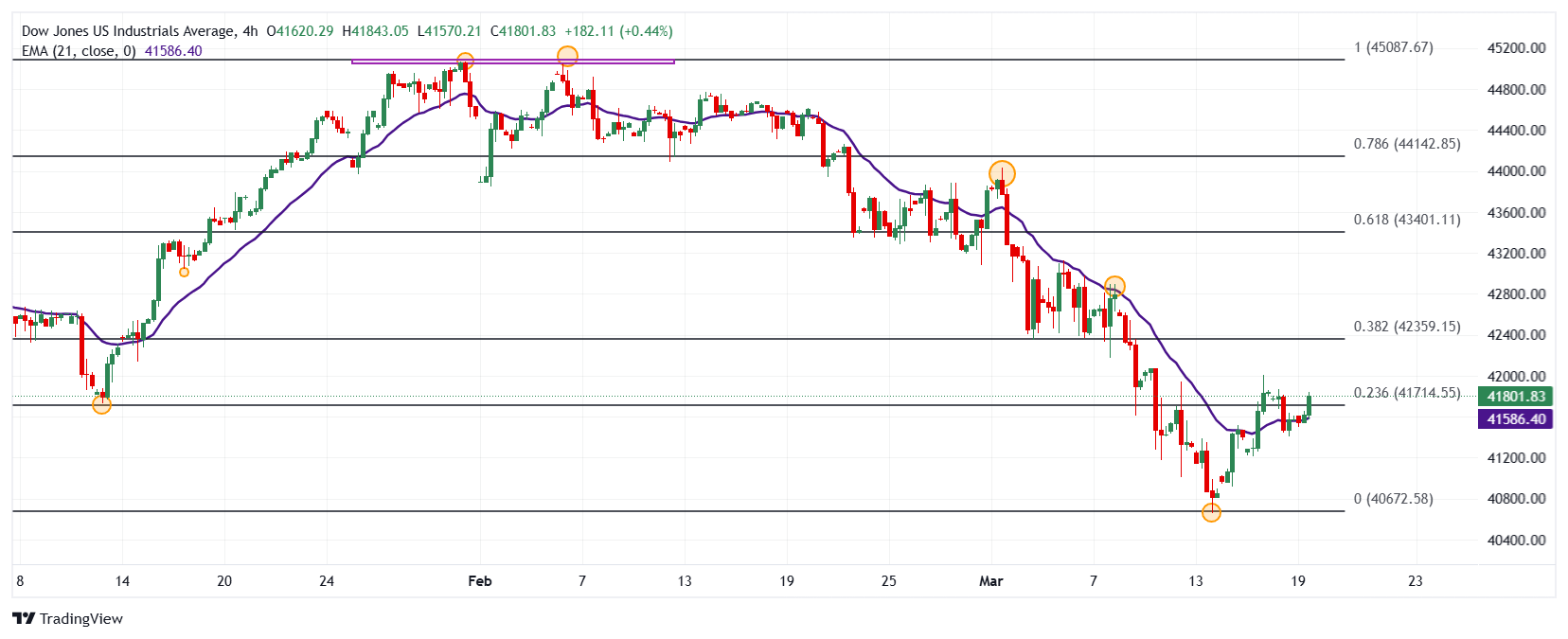- The Dow Jones wins 0.60% today.
- The Nasdaq 100 rebounds 0.76% daily, driven by Microstrategy Incorporated (Mstr).
- The S&P 500 rises 0.64% on Wednesday, led by The Boeing Company (BA).
- The focus of investors will be on the decision of interest rates, the projections and comments of the members of the FED.
The Dow Jones established a daily minimum in 41,503, finding buyers who promoted the index to a maximum of the day in 41,843, consolidating within Tuesday’s operational range.
The Dow Jones industrial average opened in 41,609 while the Nasdaq 100 technological index began operating in 19,469. The S&P 500 began negotiations in 5,614, taking up the upward perspective in tune with the main stock market rates.
American Express and Apple drive Dow Jones to profit zone
The Dow Jones index rises 0.55% daily, winning 229 points, currently operating in 41,812.
The American Express (AXP) shares rise 1.68% in the day, reaching maximums not seen since March 10 at 267.71 $, ending with a streak of two consecutive days with losses.
Following the upward perspective, Apple’s titles (AAPL) rise 1.40% daily, visiting maximum of March 12 at 218.76 $.
The buying pressure remains in force in the Dow Jones, with clear intentions, the maximum of March 17 in 42,004 in the short term will be exceeded.
The Nasdaq 100 operates on positive terrain driven by Microstrategy Incorporated and Applovin Corporation
The Nasdaq 100 technological index wins 0.85% today, operating when writing about 19,646.
Microstrategy Incorporated (MSTR) values rise 4.79% on Wednesday, reaching maximum of February 14 at 298.65 $. In the same tune the APPLOVIN CORPORATION (APP) shares recover 5.01%, contributing currently at 292.66 $, staying within the operational range of the previous session.
The S&P 500 quotes with profits by fixing its attention on the Fed type decision
The attention of the operators will be in the Federal Reserve interest decision today. The market expects the authority to maintain rates at 4.5% and make its projections known for the short, medium and long term.
The titles of The Boeing Company (BA) shoot 6.46% in the day, currently quoting about $ 171,91, reaching maximums not seen since March 3 at 173.09 $, leading the profits in the S&P 500.
Technical Analysis of Dow Jones
The Dow Jones established a short -term support given by the minimum of March 13 at 40,993. Upwards, the closest resistance is observed at 44,033, given by the maximum of March 3. The next key resistance is observed at 45,068, pivot point of January 31.
4 -hour graph of Dow Jones

Dow Jones Faqs
The Dow Jones Industrial Avenge, one of the oldest stock market indexes in the world, consists of the 30 most negotiated values in the United States. The index is weighted by the price instead of capitalization. It is calculated by adding the prices of the values that compose it and dividing them by a factor, currently 0.152. The index was founded by Charles Dow, also founder of the Wall Street Journal. In recent years it has been criticized for not being sufficiently representative, since it only follows 30 companies, unlike broader rates such as S&P 500.
There are many factors that promote the Dow Jones Industrial Average (DJIA) index. The main one is the added performance of the companies that compose it, revealed in the quarterly reports of business benefits. The American and world macroeconomic data also contribute, since they influence investor confidence. The level of interest rates, set by the Federal Reserve (FED), also influences the DJia, since it affects the cost of credit, on which many companies depend largely. Therefore, inflation can be a determining factor, as well as other parameters that influence the decisions of the Federal Reserve.
Dow’s theory is a method to identify the main trend of the stock market developed by Charles Dow. A key step is to compare the direction of the Dow Jones Industrial Avenge (DJIA) and the Dow Jones Transportation Average (DJTA) and just follow the trends in which both move in the same direction. The volume is a confirmation criterion. The theory uses elements of maximum and minimum analysis. Dow’s theory raises three phases of the trend: accumulation, when intelligent money begins to buy or sell; Public participation, when the general public joins the trend; and distribution, when intelligent money abandons the trend.
There are several ways to operate with the DJ. One of them is to use ETF that allow investors to negotiate the DJ as a single value, instead of having to buy shares of the 30 companies that compose it. An outstanding example is the SPDR Dow Jones Industrial Avenge ETF (day). Future contracts on the DJ allow the specular operators about the future value of the index and the options provide the right, but not the obligation, to buy or sell the index at a predetermined price in the future. Investment funds allow investors to buy a part of a diversified portfolio of DJ values, which provides exposure to global index.
Source: Fx Street
I am Joshua Winder, a senior-level journalist and editor at World Stock Market. I specialize in covering news related to the stock market and economic trends. With more than 8 years of experience in this field, I have become an expert in financial reporting.







